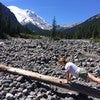Description
About This Video
Transcript
Read Full Transcript
So in this second section, I wanted to focus a little bit more on the pool up as it's often called in ballet. Um, but that I never ever understood until I actually could understand the pulling in and up and [inaudible]. Uh, so, um, you know, I feel like the, the elements of the, of the turnout and the placement and where your body should be in space needs to also then be combined with the actual holding of your trunk correctly so that then you can put those two things together and, and use it in movement. So, um, in this section we'll be talking a little bit more about what is the trunk doing during all these different turning out positions. Um, and how it can, how it can, um, you know, help the help, help the placement and help you use your turnout better. So we're just going to take the ballet stretches on the, a lot of barrels. So Kathleen is going to stand with her back to the wooden bars. Good. She's going to go ahead and take our hands and play some, that's it on the back side. Good. And from here, she is going to attempt to draw her stomach muscles in an up already as she's standing and she's going to keep her hips placed on these wooden bars to cross her right leg towards me and place it on top of the barrel. Good. So once again, she is keeping her hips connected into the back of the barrel.
She's going to start to round forward. And I try to think about this like, um, in a way that I want to be able to do all these positions without even the use of the barrel. So my abdomen is still what is actually connecting me. And if I didn't even have a barrel in front of me that I could hold my leg in the position that it's actually, um, in currently. So, so there's a little bit of a, uh, you know, an independence that the body's trying to hold onto. Good. And then let's come on up and we'll begin to arch back and for the arch, let's go ahead, let the arms slide down the sides of the barrel, right?
So you can find these frames here. Good. And then drawing the stomach muscles in and up. Good. You're going to start to lift the chest and begin to arch back and you can go as far as you want to take it. Good. Kathleen, drawing the stomach muscles in and up. Good. And then can you stand firmly into that left leg to draw the stomach and return back up? Good. Good, good. And then let's keep the leg straight and let's cross it to the opposite side of the barrel.
And similarly she's going to be connected in and up in her abdomen and start around forward and rise up and keep the stomach in and up as you begin to arch back and scoop and rise up. Let's bend at the knee, keeping the foot good, the thigh more or less in the middle of the uh, barrel. The foot to the side will once again round forward. Good. And she's doing a nice job of keeping both hips back. It gets increasingly good stretching into those turnout muscles as she does these different positions and rounding up and then lifting and arching back.
Good. And keep the energy down the standing leg. So that your stomach helps you rise back up again. Oh good, good. And we caught her, she slid the barrel a little bit again. So let's go ahead and extend the right leg out. Good. I'm going to give her a little bit of support now because now I want her body to slide into a split forward and she's gonna use her stomach to help her come back both hips at the same time to the wooden bars. Good. And once again, she can work on the turnout a little as she does this. So once again, kind of putting these two ideas together a little bit more and then try to lift to return back. Right. Nice. Nice. Nice.
Good. Let's do a third and final one. Stretching.
She's going to take this right hand and hold in front of her body. The left arm is going to come up overhead. Good. And once again, she's going to think about the lift of her stomach, right? So this hip can relax down, right as she rotates, as best she can, right? Using that barrel from assistance, but using her stomach as well. And over you go to the leg and up you return good. The left hand can come down, the right arm will go up and we'll go away from the leg.
How much more would your center have to work? Bravo. And over you go, right? So it's just like, yeah, really responsible for what she's doing in her body. Good and return. Very nice. And then over the other direction. Good. And stomach. Stomach. Stomach, right? Yes. And then rise up from that middle to return. Ah, different, different, different. Brava. Good. Let's do a couple of splits so you can hold on with both hands.
And once again we'll stretch away and she's going to try to use both hips to return to standing three times and over you go
Three dog was the best one. Brava, rotating into a second or a, the final position to taste the back. Good. Good, good. So here, uh, I'm going to have Kathleen hop up and she's just going to be kind of balancing on the pad of her foot right at the edge here. You got it. Your arms can once again slide forward. You're going to bring your hips forward to the wooden bar. Good ma'am. And you can actually sort of calm very forward down towards the toes.
The fingertips can reach down. Good. And you're still lifting in your stomach. Good. And you're gonna use that center to return back.
So this kind of echoes all the Nice c curves that we do in place. Yes. Still Scooping, right? You can think good and rising up good. Almost like when you're in Relevate and fifth right. And trying to do the contrary forward. Good. Pop to the floor. Step the left foot down. Good ma'am. And then let's do a slide back again.
Good. And just to keep moving through the stretches, we're going to take this right hand over to the opposite side. The left hand can reach back around and grab the back of the foot here. Good. Awesome. And you can use the pressure of your foot into your hand to stretch as you look and that put behind you. Wonderful. You can release the foot, bring both hands forward.
Good and your side forward. Good. And come to a passe. Taking the right dye open. Good. Let's keep lifting up in the center to slide the right foot down to stand on both legs and we'll simply turn around standing and do the other life.
I just found her taking her hip away from the, the barrel. So I just wanted to sort of emphasize the importance of that stability in that strength in the center. Good. So this time she's aware of it. We're going to keep her hips against the wood and the photo crossover. Oh yeah, good, good. There's usually a reason why the body chooses to do it on one side. Good.
So once again, let's start just simply rounding forward. Good. And so on this side we might have to be aware of her left side. Yas staying a bit more connected back. Good and rising up. Good. And then the arching back. Good.
And then crossing the foot to the opposite side. You can try to work on the turnout a little bit. She's going to make sure that left foot or left hip stays back. And once again, rounding forward. Good. And I'm going to pick on her a little bit more about how she's using your center because right, I want her to be lifting good. So that if I asked her, Kathleen, could you raise your left foot off of the barrel? That's it. That's how we write. You see how that changes the idea?
Good ma'am. Maintain that idea as you rise up tall to standing and then use that idea. If the foot had to stay off the barrel, just centimeter. Could you calm Bray back? Hold. Can you raise the leg strong? Good.
Place the leg, use your senators, return back up. Good. So you feel what I mean by that idea. Brava. Go ahead and bend at the knee and we'll go to a front attitude. Good. And then once again, so same idea if you're just aware like if I had to lift that foot off the barrel rounding forward. Yes. Good, good.
And then be aware where you don't need to work and just work where you do need to work. And then last one, arching back. Good with the awareness. Have you ever had a mean valley teacher who gave you that exercise and coming back up? Good. Good, good. They're mean, right and stretching though. Good. So we'll slide. Good. So we're going to do three slides. I'll give you a little support and then in the ideas that both hips come back at the same time.
Three times. We're going to raise the left leg up and down. Go ahead. And I really think about my standing leg. Yes. Awesome. Third time. And we'll turn to the side. Beautiful work. Good around we go. Good. And we'll hold on in front of the body and bring the right leg up.
Good a moment here. Now when we talk about turnout, there's kind of two ways to think about it. A lot of times we talk about like what, what is the placement for your body in Polonius? And I understand Joe, uh, made people work really to the side and there there can be some argument about what is better for the hip. Okay.
Now one thing I do know sort of like historically speaking is the fact that, you know, Ramana, she came from Balanchine studio and this is totally a Balanchine use of the body. Okay. So, um, you know, so take it or leave it, you know, feel what it does to your body. Uh, the idea was that you actually encumber less like friction in the joints when you're working this way. Um, and for certain, when you have the support of the, of the equipment, you know, you can kind of go for it. You can ask it of your body a little bit more, um, than maybe you would, you know, taking class. Good. So over we go and we're going to stretch. Good. And she's still thinking, if I had to lift my leg off the barrel, could I hold my body and rise up? Brava. The right hand goes down, the left arm goes up, we go the other way with the same kind of responsibilities in the body and return. Good. One more time. Each way.
Both hands can hold on. And let's do three splits. Good. And now I have, I have moved her leg back. So it's in line with her, her, her hip and her spine. And I'm still gonna ask her to try to rotate the thigh more. Good, ma'am. And once again, right? No matter what she's feeling, how that connects into that use of her belly muscles in and up. Right. And she's going to lift to return super last one.
As the thigh rotates in the belly lifts, she returns. And then holding on with both hands, standing firmly in the right leg. Let's lift the left leg and turn it out more and lifted a second time would and grow taller and lifted a third time. Awesome. Good. Kathleen. And turning to the back. Let's hop up with the right foot.
Good and thinking, pushing down to come up. Let's hop down on the right foot. Moving on. We're going to split back. She's going to move her left hand to the right side. She's going to wrap her right arm around and grab her foot.
And the second one will be, um, very similar to like our town do work, um, using a leg spring at the end of the Cadillac. So Kathleen Kamana over for the hip opener. We're going to uh, set it up by using our, our safety strap from the top and a chain, I'm sorry, a spring from the bottom. So just one spring. And then depending on if you have different weights of springs, heavy, medium light, um, I would think in terms of the fact that um, a heavy spring is going to do two things. It's going to make someone work hard. It's also going to make someone have a little bit more stability and security.
Um, so in terms of sometimes with your really like tight strong dancer, you want them to use the heavy spring cause it's actually going to make them have to stretch and release a little bit. Whereas if you had, uh, somebody who actually maybe ne might need to build some more strength, um, maybe you would use a lighter spring because then you're going to be asking that body to do more of the work itself. Um, for Kathleen, I'm giving her a nice heavy spring so she can get all kinds of wonderful feedback. Also in terms of her flexibility, I think she's pretty flexible and so I think the tight spring will actually kind of help to contain her a little bit and not let her be too, um, uh, leave her up to her own devices. She is going to have like less options available to her. So she's gonna lay on her left side facing you guys and her left hand is going to come up and hold this pipe, um, under the spring and yeah. And then one thing you can see already getting set up, one of the safety little hazards of working with this spring is, um, is, is, is for your clients getting their hair caught in the spring. So, um, in order to avoid that, if they have the flexibility like Kathleen, I can just have her stretch her arm, uh, and slide down away from the pipe.
Yup. A little bit good. And then that way she's clear of it. So that's gonna be my option for her. If, um, it was someone else who didn't have that flexibility, um, available to them, then I might just be kind of guiding my hand here as I hold the, the tower bar as well. So just things to, you know, be aware of when you're working on it. And if you're, you know, perhaps by yourself to just watch yourself. Um, the legs are going to extend out long. She's lined up so that her arm, shoulder, hip, and angles currently are all one straight, long line. And then her feet are gonna come forward on an angle. So she has this nice obtuse angle of her body. And then once again, because of her flexibility, I have this available to her. Um, she's going to raise her right foot and it's gonna turn out and come up onto this and I've got my hand on it. Good.
She is going to be aware and you are going to be aware and when you do it that you have some options as far as where your foot can be on this bar. If you have less turnout available to you, once you're in place you can bring the foot further forward. If you have more available to you, you can bring it back. Okay. Next thing, once the foot is firmly securely onto that a bar, we want to again kind of take an uh, in inventory about where the hips are. So we want one hip on top of the other and one shoulder on top of the other and it feels great from here.
Kathleen is going to start to stretch the leg out. Good. And then she's going to think about the long line of her body. She just got all that nice stretching done on the um, ladder barrel. She can now think again about how she was being responsible for home body, but now she can use a little bit more of the equipment. From here.
We'll point the foot and flex the foot and point the foot and flex the foot and [inaudible] keeping the point to the foot. Rotate your thigh a little bit more, keeping the rotation. Begin to bend the knee and keep the long spine and begin again. Lengthen the leg out. Good. Now once again, I'm going to just take a look at her hips and what I'm seeing is a little bit of a Tuck. So I'm going to ask her rye to go at length and through that right, she's got the security of the tower bar and again point flex one and keeping that long spine. Now can you talk to this thigh and ask it to turn out to and on the third and final one. Flex and 0.3. Okay. And keeping the turnout begin to open the thigh. Right.
And she's aiming it very correctly back behind her shoulder as she keeps hip on top of hip good and the rotation. Good. Third and final stretch point and flex and keep the long spine, long neck, even the long bottom leg help to make you aware of where you are in space. And keep the point to start to stretch the thigh in. Good. Good. Okay. Let's take your hand up to remove your foot. Good.
We're gonna bring the tower bar down and just turn around and facing the other direction. Good. So I can keep this spring in the same um, spot and uh, the strap and so forth. And um, this is another option you have if, if, uh, the spring is catching your hair, just oppose it from the side that you're on. Yeah. So now, once again, I'm going to help a little bit with this tower bar. She's going to bring her left foot up and again, find the placement and begin to extend the leg and she'll be aware of her long spine. Good. And Flex and 0.3 times and again, no tucking but keeping that length of the pelvis. And on the third one shall begin to rotate the thigh and aim the knee for the back of the shoulder three times. Repeat a good one. Good. And she, he now has to be a little bit more responsible again, good for keeping hip on top the hip and open it up.
Good. Good. And then it's interesting, she actually has an easier time on this leg so I can really go ahead and ask her, like to keep that alignment for herself and then keeping the turnout good. She breezed through that. Like good. Let's take your left hand up. Let's bring the knee down. We'll grab a hold of the bar. Good. And just take it down with control. Very nice. Good. Kathleen. Uh, so let's go ahead and step off. We're going to come to the end of the Cadillac over here and we're going to start with the legs spring. So we're going to use the leg sprain and um, some of the different equipment does have a slight variations on where these hooks are, but usually everybody has a low hook, might be on one side or the other of the, of the leg. Um, and then, uh, we're going to come work on just some stability and once again, thinking about her center. So I'm going to give you the springs.
You go ahead and take it yourself and you're gonna put your right foot, um, on the, around the arch of the foot to start. Good. And then I'm, Yep, she's gonna walk out here until she has a little bit of tension on the spring. Good. Good. So hands to the hips, you're going to draw your stomach muscles in and up. And I think athletes, I'm going to have you step just a tiny little bit further left. Good. And you're going to take that right foot and bring it in front of you.
I don't need to probably talk too much to her about what she's doing. Good. The one thing you want to continue, yes. To indicate yourself is to keep your strong center. Let's try five. Good. And it's all about that standing leg, standing tall, using your center. One more.
Very, very nice. Good. We're going to uh, go ahead and now, um, let's switch feet so she can still face you guys and she'll just put the other um, foot into the strap. That's it. And similarly, now she's going to be trying to sweep the left leg out and then we can turn around to do both on the other side. So once again, same concepts, standing tall, standing strong five times good. And I liked the alignment that she's using here with the spring and her foot too because it's making a pretty direct straight line out from the Cadillac.
So let's spin around and then let's begin with that same foot. Good to the inside. You got it.
Being firmly rooted into the ground is a big part of it. Good. So whether you're actually using your turnout or not. Good. And here I can ask her right to stand down into that left foot a little or sorry. Right foot. A little stronger. Good. Kathleen. That's it. Yeah. And Song and your center. Good. So Kathleen likes to, yeah, kick back in her hip a little bit to find her strength. But we're going to ask her. That's it. Let's do one more for good luck.
Brava and standing tall. Very, very nice. Changing feet and just sweeping it to the outside. Now.
Create your own internal dialogue. Good. And then add all the icing. Yes.
We're going to bring the foot in and we are going to actually kind of come into like a low attitude position. Uh, good. And that's it. And then from there, Kathleen, what you're going to do is go ahead and bend that knee a little bit more. So, right. You're kind of like in a nice modern, uh, attitude position. And then keeping the strength in the hips, keeping the strength in the stomach. She's gonna Attempt to extend that left leg on that low arabesque line and Ben back into the attitude. Good. And then repeat once again. So again, she's still having to work very strong on her standing leg to make this happen.
Good. And again, as we worked through
Good. And now I want to really see this opposition strong lift up in the front, down long through your back. Good. Last three.
Good. Bravo. Good. Let's bring the spring to the other side so that we're kind of favoring her other leg and then we'll do those same two variations. Good.
Like a nice parallel attitude. Good, good. And I'm just going to ask her to try to lift up a little bit too, so she's not sort of sitting in that hip. Good. And then going to
Nice Kathleen. Good. Keeping that right leg long and into like a low tone. Do back we reach and release. Good. And once again, right. I want to see how she's lifting up through her center to create the long lines.
Good. Last two. She's almost where I want her scooping in an app. Lengthening long through that left or right heel. That's it. Good. It's almost as if that can drop a little longer also.
I'm nice and clean. Good. Very good. Very good. So to finish, we'll work on the pedo pole. So we're gonna, uh, do some petty pole work. Once again, using like our front side back, um, attitude positions. The pedestal is so wonderful for finding your center and finding your balance. Um, I'm going to have Kathleen just begin with rising up. We'll, we'll begin in a small Relevate so not super high, but just lifting the heels up. Both heels are going to be on the pedal. Um, I'm sorry, on the pole. Good. And then correct. Right.
So you have the heels back. Good. And then all your standard ideas of working on the Pedo Pole. The idea is that we try to draw those abdominal muscles in and up and find right how much we can stack 'em ourselves up against the pole. And this pole was really meant to be the spine. So just starting simple. Let's just start by bending the knees, taking a plea, a, I'm just pause and finding a little bit of pressure down into the handles, down into the toes and then drawing in and up into the center and then keep that lift.
Good to slide up and try to stay connected to the pole. Brava and repeat once again, bending the knees. So now all that nice stretching we did to get warmed up. Bright comes into play because now we're going to try to take it up tall on top of our hips as we lift. Good. And yeah, sometimes that pelvis just wants to sneak away at the very end.
So that's where some of that sinewy stretch will come out of the hip. One more time just to find the length. So this last third and final time, Kathleen is going to draw our stomach muscles in and out. She can even push into the handles a little bit as she begins to slide up and she's gonna keep it. She's gonna keep it. She's gonna keep it, she's gonna keep, she's going to keep it to the tippy, tippy, tippy, tippy tar, keeping us. Take your heels down and let's take a little breath.
We're stacking our self block on top of block and using that center to once again rise up two more times. Good. And here she might wiggle her toes a little bit just to make sure right that she's not holding herself down there, but it's really yes, coming from the center and sort of expanding out from there and rise up. Good. Last one, third and final time. She's almost gonna let go more and not work any harder and be
She's going to take her right foot and come into an attitude.
Good. She's going to begin by lengthening out that right leg. And as the right leg lowers, she's going to try to grow taller and taller and switch feet and we'll do the other side. So to switch feet again using that opposite heel. Good. You feel why I put your heel over there? Yeah. Yeah. It helps secure the position a little bit and you can use your, your like Torx of your body a little bit more. A good.
And then once again, she's going to feel the abdomen and up. Good. Just kind of establishing like what needs to work against what. And then as she extends the leg, she, she's going to prison and ki reaching through the leg to grow taller and taller and taller and taller. Just good. Let's now rise up on a small, relevant,
Good.
And what I like about that is then you can work that and rise up. Nice. And again, bend the knee. Yes and work. Get good. And it's just a little longer to stretch through the leg. Whoa. Don't let it turn and reach long, long, long to place it. Delicious. Other side. Good, good.
So she's still got her a nice strong back and we'll go again to plays and you can work that lift. Good. And lengthen up. Nicely done. Good. What about the stomach, right, right. Use it. Go to it and use it to rise. Good. And push into those handles and lift that stomach and reach through that leg. Presenting and keep growing, growing, growing.
And let's place the feet flat. Take a little breath to go to the side. She's going to go into a small side attitude and let's just stay on flat foot for this one. Get so now the right leg can begin by turning out and reaching to the right.
You've got some things to work and help you work good. And the only thing that I'm going to ask from Kathleen is that she attempt right to present that Diane and heal a little more to me. So now two times she's going to bend in the left knee and she's gonna try to give me some more and she's
Good. And I almost feel like this rib could help you and stand up
Exactly. Exactly. When the going gets tough, the tough gotta get, don't use that right side. Tough girl. That's it. And then extending the leg out. Nice and placing it. Awesome. Take a little breath. Let's do the final variation on relevance. So she's going to go up. Good.
She's gonna again, Hook her heel on the opposite side and she's going to take a small attitude behind herself. Good. And again, with this, I like the low attitude. This is kind of like very like a towel union. 1920s Ballet, right? Scoop the stomach. Try to find again that length, right? It's kind of delicious in that hip. Yeah. And then twice we'll bend at the left knee. And again, how much can your stomach work to find that pole?
Look at that Kathleen. One more strong in your center and use that center. That same way. Good in your low attitude, stretching the leg low behind you as you grow. Grow. And it's almost like using the spring on the Cadillac to change sides. That was nicely done. Let's do the other side. Take a breath. Good.
After your neck and shoulders into your middle. Good. So again, let's pause a moment. Let's take it lower. Yes ma'am. Let's find that connection. Right? And almost, this is almost what I would more like from your body is finding, ah, the openness of that hip. Yes. Good. So now she's presenting that thigh a little bit. Yep. Stronger. And then you're going to bend at the right. Good, ma'am. And then extend and use your center against that, right.
Pilates for Athletes: Pilates for Dancers
Comments

You need to be a subscriber to post a comment.
Please Log In or Create an Account to start your free trial.
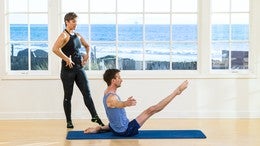
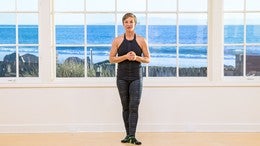
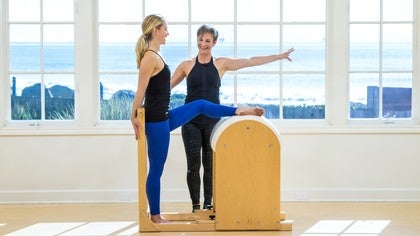
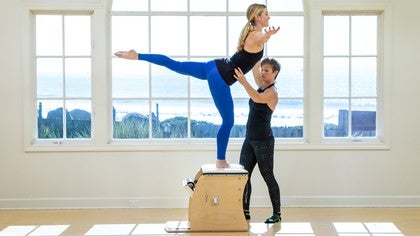
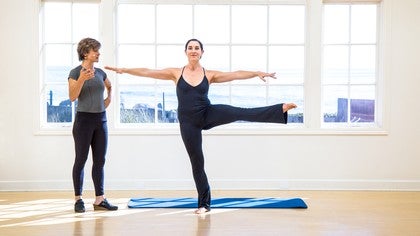
-thumb-3-80947.jpg)





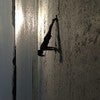
-thumb-3-80947.jpg)
